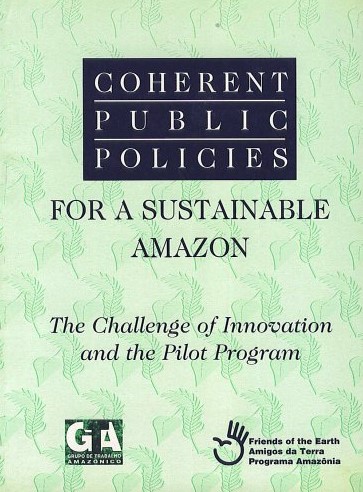

| Título | Forestry Polices: believing in management |
| Autores | Adalberto Veríssimo |
| Livro | Coherent public policies for a sustainable Amazon: the challenge of innovation and the pilot program. |
| Cidade | São Paulo |
| Ano de publicação | 1996 |
| Acesse em | https://www.amazon.com/Coherent-policies-sustainable-Challenge-Innovation/dp/B000F9NJ86 |
Veríssimo, A. 1996. Forestry polices: believing in management. In GTA & F. of the Earth (Eds.), Coherent Public Policies for a Sustainable Amazon: the Challenge of Innovation and the Pilot Program (pp. 103-109). São Paulo: Grupo de Trabalho Amazônico – GTA.
The Brazilian Amazon represents one third of the tropical forests of the world and produces 75% of the round-wood in Brazil. Exports are still modest (about 4% of global trade in tropical tim-bers), but are likely to grow with the exhaustion of Asian forests. It is predicted that, in less than three decades, the region will become the principal world center for production of tropical wood. Nevertheless, in the Amazon, as well as in other areas in the tropics, wood extraction is not managed on the basis of sus-tained yield, thus causing excessive dam-age to the forest.
The wood products sector has grown rapidly in the Amazon for a number of reasons: the construction of roads by the government in the 1960s and 70s, the exhaustion of forest stocks in the South and Southeast regions of Brazil combined with the growth of the national economy and, eventually, the fact that wood in the Amazon region is abundant and can be easily stolen or obtained at low cost.
Currently, between 20 to 25 million m³ of industrial roundwood are extracted annually in the Amazon, from an area of between 8 and 10 thousand km² of forests. For the most part, exploitation occurs within an are along the southern flank of the Amazon basin that goes from the east of Acre, passes through Rondônia and the North of Mato Grosso, until reaching the Center-South of Para. If adequately managed, wood extraction could represent a source of wealth for the region. In 1995, in Pará, where a good part of wood extraction from the region is concentrated, the forestry sector generated a gross income of US$ 0.8 billion, or 13% of the state’s total economic output.
This post was published on 7 de junho de 1996
Título Índice de Progresso Social Brasil 2025 Autores Melissa Wilm Daniel Santos Beto Veríssimo Marcelo…
Amorim, L., Ferreira, R., Dias, M., Souza Jr., C., & Veríssimo, A. Sistema de Alerta…
Título Fatos da Amazônia 2025 Autores Daniel Santos Manuele Lima Agatha Vilhena Beto Veríssimo Caíque…
Amorim, L., Ferreira, R., Dias, M., Souza Jr., C., & Veríssimo, A. Sistema de Alerta…
Título A Vocação da Restauração Florestal na Amazônia com Base na Vegetação Secundária Autores Jayne…
Amorim, L., Ferreira, R., Dias, M., Souza Jr., C., & Veríssimo, A. Sistema de Alerta…